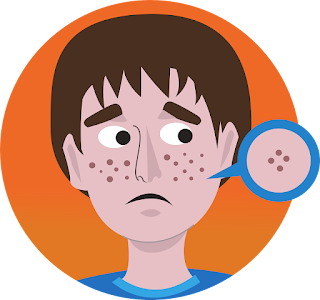Dry Skin, Definition, Cause, Prevention and Treatment (Simple Home Remedies)
What is dry skin?
Almost everyone (adult and children) at some stage in their lives has experienced dry skin. Dry skin is one of the most common skin conditions
albeit with varying severity.
The term dry skin simply refers to skin that feels and looks
dry. Depending on the skin tone, the term “ashy skin” is also a common description.
Skin feels and looks dry when it lacks moisture in its outer layer. Extremely dry skin could crack on the surface.
The medical term for abnormally dry skin is xerosis,
xeroderma or asteatosis (lack of fat).
Who gets dry skin?
Dry skin can affect males and females of all ages. Sometimes
children develop extreme forms of dry skin in early childhood, this is often
the case when it runs in the family. Some skin conditions like atopic
dermatitis have a positive correlation to dry skin. That said, studies have shown
that there is some racial variability in water and lipid content of the skin. there
are certain skin conditions that seem to affect dark skin more frequently or
with more severity, dry skin is one of them. People suffering from some chronic
health conditions or on some medications may be predisposed to dry skin.
What causes dry skin?
Any factor that negatively affects the barrier function of
the skin, leading to an overall shortfall in the ability of the skin to retain moisture,
would have a causative effect.
There is a long list of factors including inherited and
acquired health conditions. Systemic diseases such as thyroid disease and
diabetes can increase the risk of severely dry skin.
the most common causes of dry skin however are part of our day
to day activities.
·
Environmental triggers; a dry environment with low
humidity eg in desert climates or winter.
·
Excessive air conditioning, direct heat from a
fire or a fan heater.
·
Excessive bathing, showering or hand washing.
·
Immoderate use of shower gels, soap, detergents,
and solvents.
·
Use of some topical agents containing alcohol.
·
Frictional irritation from rough clothing or
abrasives.
What are the signs of dry skin?
If you feel your skin is dry, or you find yourself going
through tons of moisturisers, then you very much likely have dry skin. However, in severely dry skin, the signs are
more visible and often causes more discomfort.
Extremely dry skin is rough, scaly, itchy, dull, and
cracked. In darker skin tones, patches of grey, ashy-looking skin are often one
of the signs.
If you find your skin
red, painful, peeling, inflamed or fissured with areas of infection with pus, blisters, odour,
or if you develop difficulty sleeping at night due to severe discomfort, make sure
to contact a health professional.
What Happens if dry skin is not treated?
Apart from the worsening discomfort caused by the symptoms
listed above, when left untreated, dry skin could lead to conditions such as
eczema/dermatitis, skin infection when bacteria or viruses penetrate an opening on the skin surface, overheating of the skin (in ichthyosis), contact allergy, and
most of all, a terrible looking skin.
How can dry skin be prevented?
·
The most important answer to this question is MOISTURIZE!
be generous with this.
·
Reduce the frequency of bathing. Shower only
once a day unless absolutely necessary.
·
When you wash or shower, avoid using harsh soaps
or shower gel.
·
Replace standard soap with a substitute such as
a synthetic detergent cleanser, water-soluble emollient, bath oil,
anti-pruritic tar oil, colloidal oatmeal etc.
·
After a shower, no need to completely dry up
before applying a moisturiser, pat or dab, do not rub.
·
Leaving some trace of water on your skin after a shower helps the absorption of moisturizers.
·
Wash your hands rather than use alcohol gel
whenever possible.
·
Use lukewarm, not hot, water.
·
In winter, layer up to avoid having to use the
heater frequently.
·
keep moisture levels up indoors. A humidifier in
winter and air conditioner in summer
·
Drink water.
What is the treatment for dry skin?
This is where the ole saying “prevention is better than cure”
has never been more applicable. You should get ahead of the game and MOISTURIZE
before it is too late.
The mainstay of treatment of dry skin and ichthyosis is
moisturisers/emollients. They should be applied liberally at least 2 times a
day. Emollients generally work best if applied to damp skin.
Topical steroid and/or other prescription treatments may be necessary
depending on severity. You should speak to your doctor if you are suffering
from symptoms of severe dry skin or if your symptoms are not improving/getting
worse, despite the use of over-the-counter remedies.
But, other times, with the right home treatments and
self-care, you may be able to find relief for your skin.
Home Remedies for dry skin
As a self-proclaimed lover of all things natural, this article
will be deficient without me sending you all to your kitchen cupboards. No
doubt whatsoever that you have at least one of these remedies already lying
around.
·
Honey
·
Aloe vera
·
Oatmeal for baths
In conclusion, a tendency to dry skin may persist life-long, or it may improve once the contributing factors are controlled. Whatever the case, take a holistic approach to caring for your health in general and watch everything else fall in place.
If you got 99 problems, skin should certainly not be one of
them.





Comments
Post a Comment